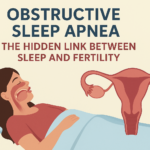Oct 8th, 2021|| Eye Problems, OSA by Dr.Manvir Bhatia & Saunri

Introduction
The word ‘Apnea’ means cessation of breathing. Obstructive sleep apnea (OSA) is the most common type of sleep apnea, in which the airway becomes narrowed, blocked, or floppy during sleep, thus causing disrupted sleep, loud snoring, and frequent awakening during sleep. The prevalence of OSA is predicted to rise with rising in obesity which is the most common risk factor. While cardiovascular, respiratory, metabolic disorders have been associated with OSA, it is also critical to recognize visual conditions that might be associated with OSA.
Why does OSA occur?
In OSA, during sleep, the muscles of the airway relax excessively, creating a negative pressure that pulls in the walls of the airway, obstructing or narrowing it, and causing interruptions in breathing. As a result of these obstructing events, oxygen saturation may also be reduced periodically. Desaturation of oxygen leads to the release of inflammatory cytokines and catecholamines, which are responsible for injury repair of blood vessels.
Eye problems are seen in OSA sufferers.
Ocular manifestations of OSA obtained from the mechanical and vascular effects of the syndrome include floppy eyelid syndrome, nonarteritic anterior ischemic optic neuropathy, central serous retinopathy, and glaucoma.
Glaucoma
Glaucoma is a condition in which there is chronic neuropathy of the optic nerve. It is the second-largest cause of blindness. People with OSA are more likely to suffer from Glaucoma. This is thought to occur because of recurrent hypoxia, increased vascular resistance, and oxidative stress damage to the optic nerve that happens during episodes of interrupted breathing. Moreover, studies have also shown that there is thinning of the retinal fiber layer, alteration of optic nerve head, choroidal and macular thickness and reduced visual field sensitivity in OSA patients who do not have Glaucoma, putting them at risk of developing it later. Collective data from numerous studies have suggested that patients with Obstructive Sleep Apnea have a 1.67 times higher risk of developing Glaucoma within the first five years of being diagnosed with OSA. According to a study carried out in 2008 and published in Eye among the American Population, around 27% of OSA patients developed Glaucoma.
Floppy eyelid syndrome (FES)
Floppy eyelid syndrome is a condition in which the upper eyelids easily turn in the upward direction. It is characterized by relaxing floppy eyelids presenting as recurrent or chronic ocular surface irritation and chronic papillary conjunctivitis of upper palpebral conjunctiva (common in obese patients). According to a study published in Sleep Medicine Reviews with FES patients, 96% of patients experienced symptoms associated with OSA.
Nonarteritic Anterior Ischemic Optic Neuropathy (NAION)
NAION is characterized by a sudden, painless, irreversible, and nonprogressive visual loss. A study published in the American Journal of Ophthalmology found that the chances of the development of NAION in patients with untreated OSA are increased by 16%. It may not be possible to reverse vision loss from NAION, treatment for OSA can help prevent an attack of NAION in the other eye, which occurs in 15 to 18 percent of cases.
Central serous retinopathy (CSR)
Central serous retinopathy results in an idiopathic detachment of the retina due to serous fluid collection beneath the retina. A study published in Sleep and Breathing found that CSR is associated with OSA. Circulating epinephrine and norepinephrine levels increase in patients with OSA, exerting endothelial dysfunction on the blood-retinal barrier, which may lead to the accumulation of subretinal serous fluid.
Conclusion
Patients with OSA show increased risk for several vision-threatening ocular conditions. Ophthalmologists may spot signs of visual conditions linked with sleep apnea using a tool such as the Epworth Sleepiness Scale or Berlin Questionnaire or order a sleep study, allowing them not only to detect ocular manifestations associated with OSA at a stage early enough to maintain and restore vision but also to help in the management and prevention of well-known systemic comorbidities.
To seek help or know more eye problems associated with OSA, you can visit the Neurology and Sleep Centre, the 1st sleep center in the country accredited by the Indian Board of Sleep Medicine at L-23, Hauz Khas Enclave, New Delhi, Delhi-110016 (INDIA)
Or give a call on +91-11-46070321, +91-9643500270
References
Park, J. G., Ramar, K., & Olson, E. J. (2011). Updates on definition, consequences, and management of obstructive sleep apnea. Mayo Clinic Proceedings, 86(6), 549–555.
Leger, D., Bayon, V., Laaban, J. P., & Philip, P. (2012). Impact of sleep apnea on economics. Sleep medicine reviews, 16(5), 455–462.
Gozal, D., & Kheirandish-Gozal, L. (2008). Cardiovascular morbidity in obstructive sleep apnea: oxidative stress, inflammation, and much more. American journal of respiratory and critical care medicine, 177(4), 369–375.
Nácher, M., Farré, R., Montserrat, J. M., Torres, M., Navajas, D., Bulbena, O., & Serrano-Mollar, A. (2009). Biological consequences of oxygen desaturation and respiratory effort in an acute animal model of obstructive sleep apnea (OSA). Sleep medicine, 10(8), 892–897.
Santos, M., & Hofmann, R. J. (2017). Ocular Manifestations of Obstructive Sleep Apnea. Journal of clinical sleep medicine : JCSM: official publication of the American Academy of Sleep Medicine, 13(11), 1345–1348.
McNab A. A. (2007). The eye and sleep apnea. Sleep medicine reviews, 11(4), 269–276.
Miyamoto, C., Espírito Santo, L. C., Roisman, L., Moreno, P., Cariello, A. J., & Osaki, M. H. (2011). Floppy eyelid syndrome: review. Arquivos brasileiros de oftalmologia, 74(1), 64–66.
Gaier, E. D., & Torun, N. (2016). The enigma of nonarteritic anterior ischemic optic neuropathy: an update for the comprehensive ophthalmologist. Current opinion in ophthalmology, 27(6), 498–504.
Stein, J. D., Kim, D. S., Mundy, K. M., Talwar, N., Nan, B., Chervin, R. D., & Musch, D. C. (2011). The association between glaucomatous and other causes of optic neuropathy and sleep apnea. American journal of ophthalmology, 152(6), 989–998.e3.
Huon, L. K., Liu, S. Y., Camacho, M., & Guilleminault, C. (2016). The association between ophthalmologic diseases and obstructive sleep apnea: a systematic review and meta-analysis. Sleep & breathing = Schlaf & Atmung, 20(4), 1145–1154.
Bendel, R. E., Kaplan, J., Heckman, M., Fredrickson, P. A., & Lin, S. C. (2008). Prevalence of glaucoma in patients with obstructive sleep apnoea—a cross-sectional case series. Eye, 22(9), 1105-1109.











